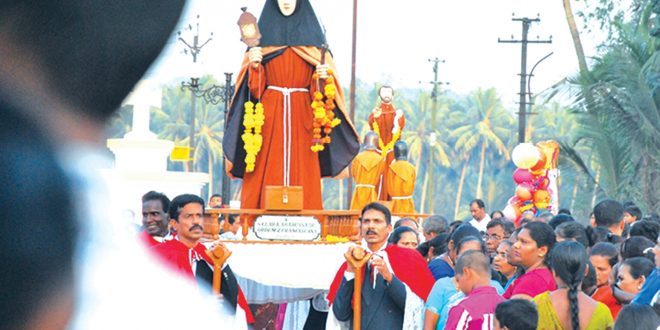Goa is a state that has a large number of devout Catholics. You see these people in the numerous villages that surround the major towns in the state. In fact, today is the day of Santachem Pursanv or the Penitential Procession of Saints. This is a unique procession that takes place every year at St. Andrew’s Church in Goa Velha.
The history of Santachem Pursanv
In the past, processions were held during almost every Catholic feast. Now, there aren’t very many processions and the Santachem Pursanv is just one of the two traditional processions still alive in our tiny home state.
This is a tradition that dates back to the 17th century. When the tradition began, a total of 65 life-sized richly decorated statues of saints, martyrs, kings, and queens that were carried in palanquins on the shoulders of native Christians. Unfortunately, only 31 statues remained until the end of the 19th century.
The processions that existed in the old days were many. These included the “Corpus Christi’ procession which was held on the first Thursday after Low Sunday, the procession of the Rosary by the Dominican fathers, the procession of the flagellants, and that of the ” bones of the Hanges” by the Confraternity of Charity.
All these eventually died out or were banned for various reasons.
As of today, there are two traditional processions that continue to exist with fervor. These being the procession of the “Capas Magna” at the Se Cathedral in Old Goa which is most commonly known in Goa as the “Xeppdeanchem Pursanv” on Good Friday. The second is, of course, the procession of the “Santachem Pursanv” held at Goa Velha on the Monday after Passion Sunday ( 5th Sunday of Lent). You will not find these two processions happening anywhere else in the world beside Rome.
Therefore, it is also interesting to see how the ritual practices of Lenten tableaus which were practiced back then, still continue to this day.
How Santachem Pursanv unfolds
Santachem Pursanv begins with a Eucharist celebration held in the church square annually with a particular theme. Speaking to the Navhind Times, parish priest of St. Andrew’s Church, Goa Velha said, “This year the theme of the Eucharistic celebration is ‘Santa bhokta baxen mogan jieun jezuchea utrak zaiti follam diunk ani tachem utor dusreank shikounk dev amkam apoita’ (God calls us to live and spread his Word like the saints did).”
He further added, “The old artistic images of saints emerge out of the church with a priest, a nun and a lay person speaking through a microphone narrating the life-story of each saint in Konkani.”
After the celebration, the images are brought out in a particular order from the main door of St Andrew’s Church. They are placed in front of the outdoor altar. The procession then moves on the traditional path via the Goa Velha Market while devotees walk behind each charol (tableau).
The order of the procession
The first charol is the Franciscan Coat of Arms, followed by all other images shouldered by the confraria members of the Church. Throughout the procession, devotees pray the rosary and the choir sing hymns. The devotees seek blessings through the intercession of the saints by passing from under the charols and also ask for forgiveness for their sins.
After the procession crosses the Goa Velha Market it takes a left turn on the old National Highway and later another left onto the Batim-Merces road. A little ahead it takes another left turn to the church street and then straight to the Church compound. The procession is followed by a three-day public veneration. The next day after the morning masses, the veneration of the holy statues begins.
This “Procession of Saints was started to inculcate a sense of spirit of prayer and penance into the hearts and minds of the faithful. The saints were taken as role models who actually were simple people belonging to this world and who devoted their lives to Christ and thereby sanctified themselves.
The history of this particular procession is quite interesting. You can more in-depth information from the link below.
Information source – The Navhind Times/ The History of Goa Velha’s Pursanv
ItsGoa/MAR/KDGP


